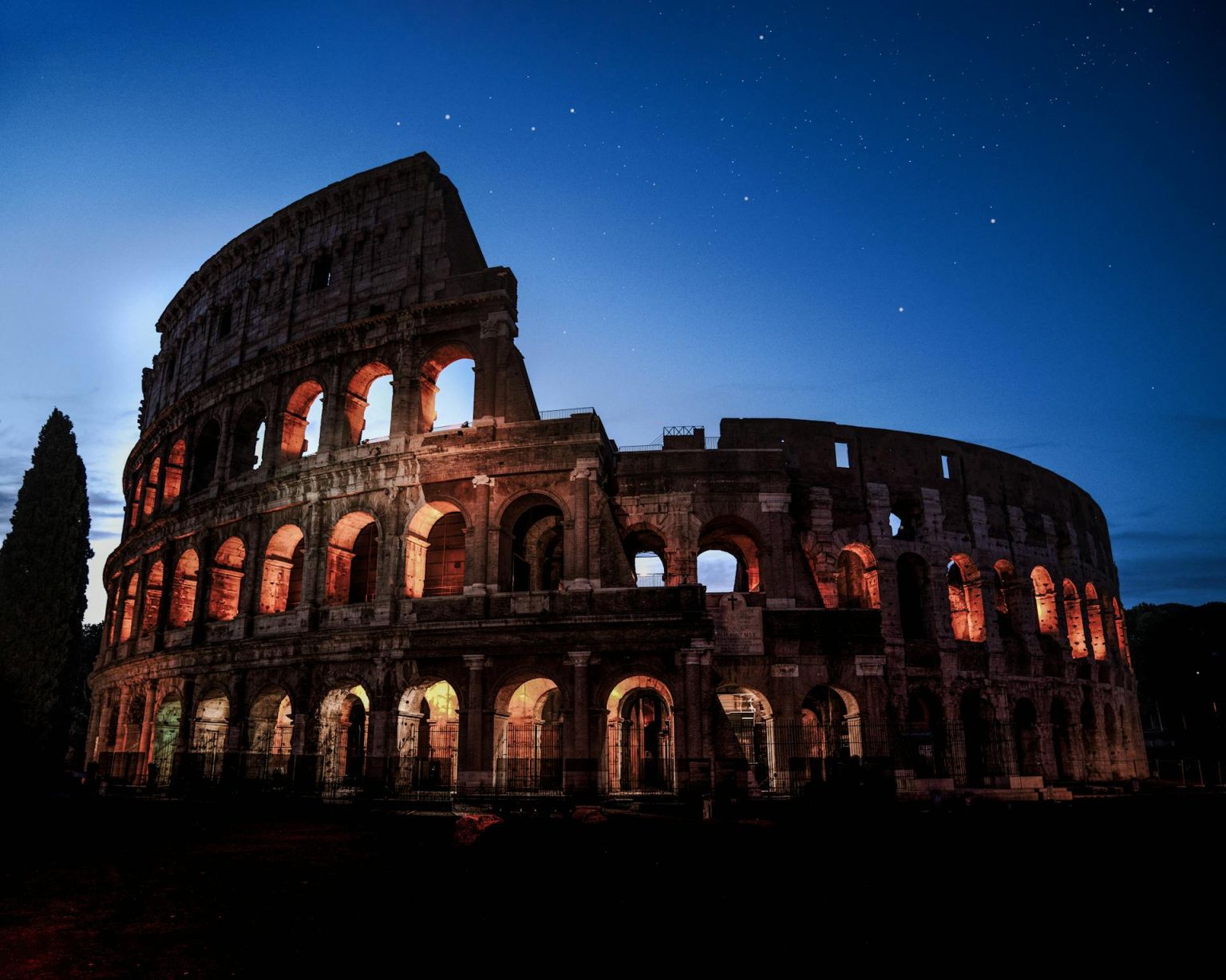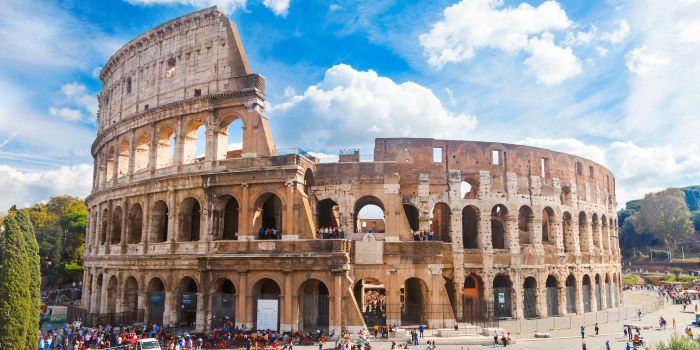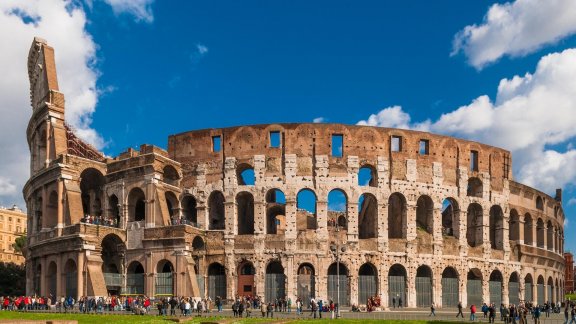Colosseum: the eternal symbol of Rome
Colosseum: the tickets most chosen by travelers
Colosseum: The must-see attraction in Rome
Anyone visiting Rome simply must see the Colosseum. This iconic monument, a UNESCO World Heritage site and one of the Seven Wonders of the World, is the most loved and visited attraction in Rome. Built between 70 and 80 AD, the Colosseum is the largest amphitheater ever constructed and a masterpiece of Roman engineering.
Originally used for public spectacles and gladiator battles with wild animals, today the Colosseum offers a unique window into ancient Rome. Walking through its imposing ruins feels like traveling back in time, immersing yourself in the grandeur of its past. The Colosseum stands tall in all its magnificence at the heart of Rome, near the Roman Forum and the Palatine Hill.
Even viewing it from the outside is an unforgettable experience—at night, when illuminated, it offers an even more breathtaking sight! But it’s the tour of the internal areas that provides the unforgettable experience you're looking for. For lovers of history, art, and culture, visiting the Colosseum means coming into direct contact with one of the wonders of the world.
The Best Tours to Visit the Colosseum
Visit all the main attractions of the Archaeological Park with a guided tour of about 3 hours. Ideal if you don’t want to miss anything in this archaeological area.

Discover all other experiences
Useful Information for Visiting the Colosseum
Opening Hours:
The Colosseum is open daily, starting at 8:30 am. The Roman Forum and Palatine Hill open at 9:00 am. The Archaeological Park closes at 6:30 pm, with the last entrance at 5:30 pm.
Booking: To avoid long waits, it's highly recommended to book tickets in advance online. There are various options available, including basic tickets, guided tours, and packages that also include access to the Roman Forum and Palatine Hill. Booking ahead saves time and ensures your preferred time slot. Entry to the Colosseum is personalized.
Last-Minute Tickets: If you haven’t booked in advance, you can still purchase last-minute tickets online or at the ticket office on-site, although this may involve long lines, especially during peak season.
Where to Enter the Colosseum:
Entrance for individual visitors: Reserved for those with single tickets, whether a standard ticket, a "Skip the Line" ticket, or part of a guided tour.
- Group entrance: Exclusively for groups visiting the Colosseum with a professional guide.
- Stern Entrance: Reserved for visitors accompanied by an accredited tour guide.
You’ll need to choose your entrance based on the type of ticket you’ve purchased.
Colosseum: tips for your visit
How to Get to the Colosseum
Metro:
Take Line B and get off at the Colosseo stop. The monument is just a short walk from the station.
Bus:
Several lines serve the area, including 75, 81, and 175. The stops are close to the Colosseum.
By Foot:
Enjoy a scenic walk and take in other historical attractions along the way, like the Roman Forum and the Palatine Hill.
Bicycles and Electric Scooters:
Convenient options thanks to the many bike lanes in the city.
Car:
The area has restricted traffic, and parking is limited. It's recommended to use nearby public parking or alternative transport options
The best experiences in Rome
Best attractions around Colosseum
all entrance tickets for the most popular Italian attractions
St.Peter's Basilica
RomeVatican Museum
RomePantheon
RomeTrevi Fountain
RomeSistine Chapel
RomeSant'Angelo Castle
RomeTivoli Villas
RomeBorghese Gallery
RomePlaces to visit in Rome: your full guide to the eternal city
Rome, an extraordinary city to visit but, above all, to love. Find out with us all you have to know before visiting the best places in Rome.
Read more
FAQ about the Colosseum
What are the Colosseum’s opening hours?
The Colosseum is open daily from 9:00 am until one hour before sunset, with seasonal variations. It is closed on December 25 and January 1.
How much does the entry ticket cost?
The standard ticket costs around €16-18, but "Skip the Line" options or combination packages with the Roman Forum and Palatine Hill are available. Students and EU citizens under 25 are eligible for discounted rates, while children under 18 enter for free.
Can I visit the Colosseum’s underground?
Yes, but only through guided tours. The underground areas include the spaces where gladiators and animals waited before entering the arena.
How long does a Colosseum visit take?
A standard visit lasts about 1-2 hours, but including the Roman Forum and Palatine Hill can take 3-4 hours.
Can I visit the Colosseum at night?
Yes, during certain times of the year, evening tours are available, offering a quieter and more atmospheric experience.
Is it accessible for people with disabilities?
The Colosseum is partially accessible with ramps and elevators, but some areas may be difficult to reach for those with limited mobility.
Discover the Colosseum Archaeological Park: What attractions are included?
The Colosseum is part of a vast complex of monuments known as the Colosseum Archaeological Park. This park, covering 40 hectares in the heart of Rome, was established as an autonomous body by the Ministry of Culture in 2017, offering visitors a unique experience. Within the park, you will find the following museum areas and attractions:
- The Colosseum
- The Roman Forum
- The Palatine Hill
- The Domus Aurea
These wonders can also be visited with a single ticket. Not all tickets include all museum areas, so it’s recommended to check in advance which type of ticket for the Colosseum Archaeological Park suits your needs best.
Fun Facts About the Colosseum
Original Name: The Colosseum was originally known as the Flavian Amphitheater, named after the dynasty of emperors who commissioned its construction. The name "Colosseum" likely comes from the nearby statue of the Colossus of Nero.
Capacity: It could accommodate about 50,000 to 80,000 spectators. Entry was free for all, with seating assigned based on social class.
Games Duration: The inaugural celebrations for the Colosseum lasted 100 days, featuring gladiator battles and wild animal hunts.
Underground Areas: The Colosseum has a complex system of underground passages, called the "hypogeum," where gladiators and animals were kept before being brought into the arena via platforms and lifts.
Later Uses: After the fall of the Roman Empire, the Colosseum was used as a fortress, a quarry for building materials, and even a church.
Damage: Despite being a symbol of Rome, the Colosseum has suffered various damages over the centuries due to earthquakes and the extraction of stones for construction purposes.
UNESCO Heritage: The Colosseum was added to the UNESCO World Heritage list and, in 2007, was named one of the New Seven Wonders of the World."
























Redazione Visit Italy
Colosseum tickets: tours, information, and tips for visiting Italy's oldest and most beloved monument.